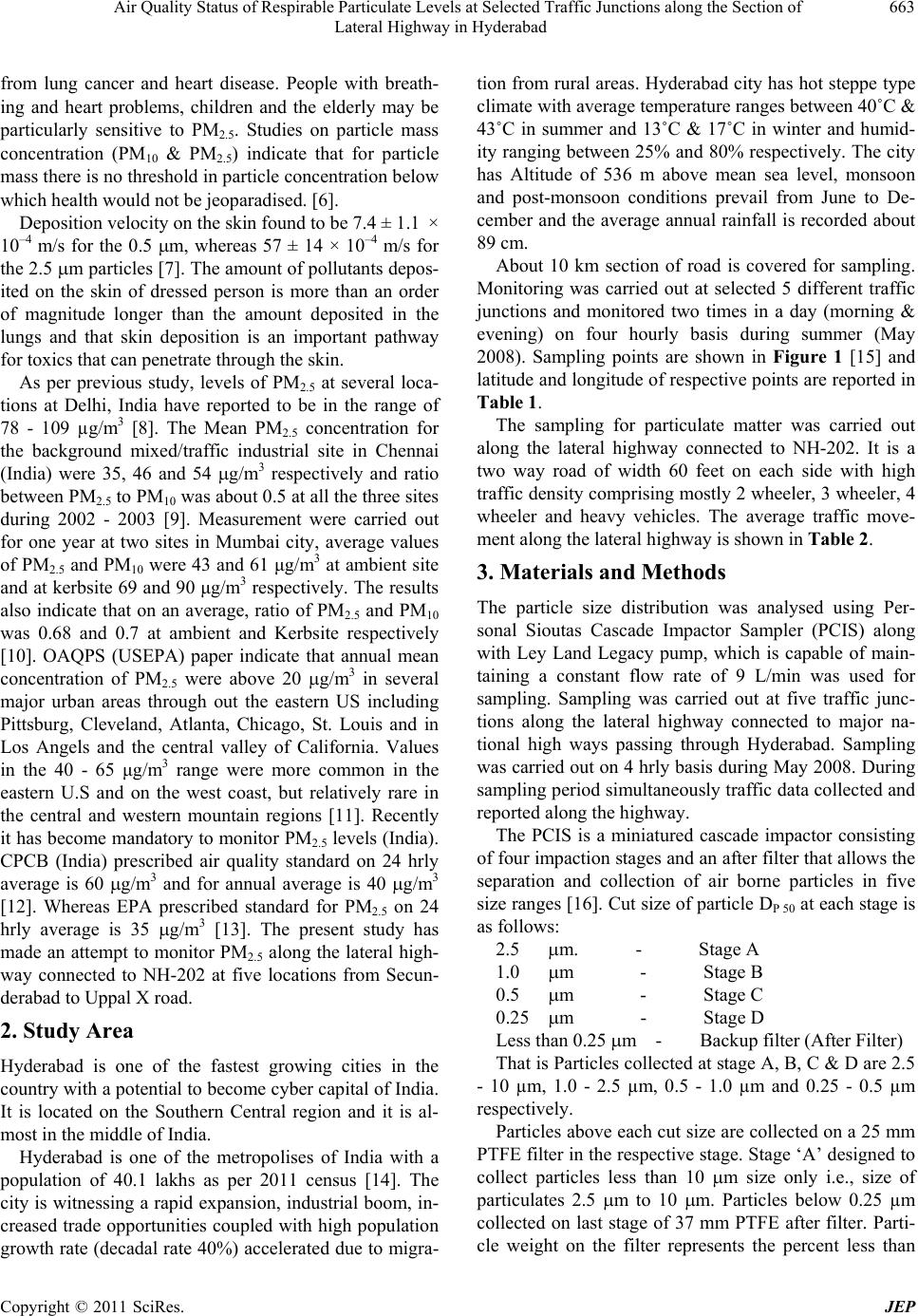
Air Quality Status of Respirable Particulate Levels at Selected Traffic Junctions along the Section of 663
Lateral Highway in Hyderabad
from lung cancer and heart disease. People with breath-
ing and heart problems, children and the elderly may be
particularly sensitive to PM2.5 . Studies on particle mass
concentration (PM10 & PM2.5) indicate that for particle
mass there is no threshold in particle concentration below
which health would not be jeoparadised. [6].
Deposition velocity on the skin found to be 7.4 ± 1.1 ×
10–4 m/s for the 0.5 m, whereas 57 ± 14 × 10–4 m/s for
the 2.5 m particles [7]. The amount of pollutants depos-
ited on the skin of dressed person is more than an order
of magnitude longer than the amount deposited in the
lungs and that skin deposition is an important pathway
for toxics that can penetrate through the skin.
As per previous study, levels of PM2.5 at several loca-
tions at Delhi, India have reported to be in the range of
78 - 109 µg/m3 [8]. The Mean PM2.5 concentration for
the background mixed/traffic industrial site in Chennai
(India) were 35, 46 and 54 g/m3 respectively and ratio
between PM2.5 to PM10 was about 0.5 at all the three sites
during 2002 - 2003 [9]. Measurement were carried out
for one year at two sites in Mumbai city, average values
of PM2.5 and PM10 were 43 and 61 μg/m3 at ambient site
and at kerbsite 69 and 90 μg/m3 respectively. The results
also indicate that on an average, ratio of PM2.5 and PM10
was 0.68 and 0.7 at ambient and Kerbsite respectively
[10]. OAQPS (USEPA) paper indicate that annual mean
concentration of PM2.5 were above 20 g/m3 in several
major urban areas through out the eastern US including
Pittsburg, Cleveland, Atlanta, Chicago, St. Louis and in
Los Angels and the central valley of California. Values
in the 40 - 65 μg/m3 range were more common in the
eastern U.S and on the west coast, but relatively rare in
the central and western mountain regions [11]. Recently
it has become mandatory to monitor PM2.5 levels (India).
CPCB (India) prescribed air quality standard on 24 hrly
average is 60 g/m3 and for annual average is 40 g/m3
[12]. Whereas EPA prescribed standard for PM2.5 on 24
hrly average is 35 g/m3 [13]. The present study has
made an attempt to monitor PM2.5 along the lateral high-
way connected to NH-202 at five locations from Secun-
derabad to Uppal X road.
2. Study Area
Hyderabad is one of the fastest growing cities in the
country with a potential to become cyber capital of India.
It is located on the Southern Central region and it is al-
most in the middle of India.
Hyderabad is one of the metropolises of India with a
population of 40.1 lakhs as per 2011 census [14]. The
city is witnessing a rapid expansion, industrial boom, in-
creased trade opportunities coupled with high population
growth rate (decadal rate 40%) accelerated due to migra-
tion from rural areas. Hyderabad city has hot steppe type
climate with average temperature ranges between 40˚C &
43˚C in summer and 13˚C & 17˚C in winter and humid-
ity ranging between 25% and 80% respectively. The city
has Altitude of 536 m above mean sea level, monsoon
and post-monsoon conditions prevail from June to De-
cember and the average annual rainfall is recorded about
89 cm.
About 10 km section of road is covered for sampling.
Monitoring was carried out at selected 5 different traffic
junctions and monitored two times in a day (morning &
evening) on four hourly basis during summer (May
2008). Sampling points are shown in Figure 1 [15] and
latitude and longitude of respective points are reported in
Table 1.
The sampling for particulate matter was carried out
along the lateral highway connected to NH-202. It is a
two way road of width 60 feet on each side with high
traffic density comprising mostly 2 wheeler, 3 wheeler, 4
wheeler and heavy vehicles. The average traffic move-
ment along the lateral highway is shown in Table 2.
3. Materials and Methods
The particle size distribution was analysed using Per-
sonal Sioutas Cascade Impactor Sampler (PCIS) along
with Ley Land Legacy pump, which is capable of main-
taining a constant flow rate of 9 L/min was used for
sampling. Sampling was carried out at five traffic junc-
tions along the lateral highway connected to major na-
tional high ways passing through Hyderabad. Sampling
was carried out on 4 hrly basis during May 2008. During
sampling period simultaneously traffic data collected and
reported along the highway.
The PCIS is a miniatured cascade impactor consisting
of four impaction stages and an after filter that allows the
separation and collection of air borne particles in five
size ranges [16]. Cut size of particle DP 50 at each stage is
as follows:
2.5 m. - Stage A
1.0 m - Stage B
0.5 m - Stage C
0.25 m - Stage D
Less than 0.25 m - Backup filter (After Filter)
That is Particles collected at stage A, B, C & D are 2.5
- 10 µm, 1.0 - 2.5 µm, 0.5 - 1.0 µm and 0.25 - 0.5 µm
respectively.
Particles above each cut size are collected on a 25 mm
PTFE filter in the respective stage. Stage ‘A’ designed to
collect particles less than 10 m size only i.e., size of
particulates 2.5 m to 10 m. Particles below 0.25 µm
collected on last stage of 37 mm PTFE after filter. Parti-
cle weight on the filter represents the percent less than
Copyright © 2011 SciRes. JEP